
The redback spider, also known as the Australian black widow, is a species of highly venomous spider believed to originate in South Australia or adjacent Western Australian deserts, but now found throughout Australia, Southeast Asia and New Zealand, with colonies elsewhere outside Australia. It is a member of the cosmopolitan genus Latrodectus, the widow spiders. The adult female is easily recognised by her spherical black body with a prominent red stripe on the upper side of her abdomen and an hourglass-shaped red/orange streak on the underside. Females usually have a body length of about 10 millimetres (0.4 in), while the male is much smaller, being only 3–4 mm (0.12–0.16 in) long.
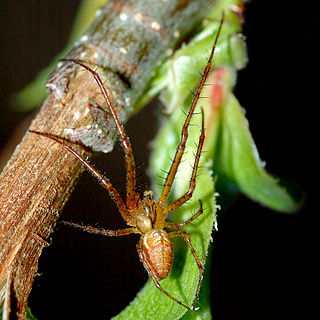
Long-jawed orb weavers or long jawed spiders (Tetragnathidae) are a family of araneomorph spiders first described by Anton Menge in 1866. They have elongated bodies, legs, and chelicerae, and build small orb webs with an open hub with few, wide-set radii and spirals with no signal line or retreat. Some species are often found in long vegetation near water.

The katipō is an endangered species of spider native to New Zealand. It is one of many species in the genus Latrodectus, such as the Australian redback, and the North American black widow. The species is venomous to humans, capable of delivering a potentially dangerous bite. It is a small to medium-sized spider, with the female having a round black or brown pea-sized body. Red katipō females found in the South Island and the lower half of the North Island, are always black, and their abdomen has a distinctive red stripe bordered in white. In black katipō females found in the upper half of the North Island, this stripe is absent, pale, yellow, or replaced with cream-coloured blotches. These two forms were previously thought to be separate species. The male is much smaller than the female and quite different in appearance: white with black stripes and red diamond-shaped markings. Katipō are mainly found living in sand dunes close to the seashore. They are found throughout most of coastal New Zealand except the far south and west. Katipō feed mainly on ground dwelling insects, caught in an irregular tangled web spun amongst dune plants or other debris.

Nephila is a genus of araneomorph spiders noted for the impressive webs they weave. Nephila consists of numerous species found in warmer regions around the world, although some species formerly included in the genus have been moved to Trichonephila. They are commonly called golden silk orb-weavers, golden orb-weavers, giant wood spiders, or banana spiders.
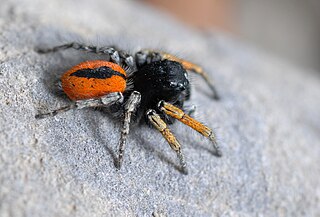
Philaeus chrysops is a species of jumping spider (Salticidae).
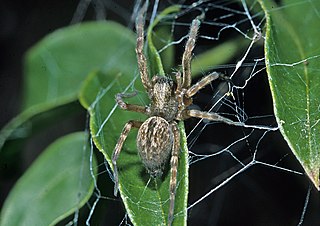
Badumna is a genus of intertidal spiders that was first described by Tamerlan Thorell in 1890. They are harmless spiders that can be found around human structures and buildings. The most well-known species is B. insignis, also known as the "black house spider" or "black window spider".

Leucauge is a spider genus of long-jawed orb weavers, with over 160 species and fully pantropical distribution.

Leucauge venusta, known as the orchard orbweaver spider, is a long-jawed orbweaver spider that occurs from southern Canada to Colombia, along the East coast, reaching into the central US, also in South Asia. The web is often oriented horizontally, with the spider hanging down in the center.
Nigricauda, a Latin word meaning black-tailed, may refer to:

Leucauge argyra is a spider found North, Central and South America (from United States to Brazil and the Caribbean. Leucauge argyra is known to be a colonial species, with spiders maintaining individual territories/orb webs within a scaffolding of shared support lines maintained by the group. Colonies of multi-generational individuals are often seen with some levels of size stratification. It is known for being the host of the Hymenoepimecis argyraphaga, a Costa Rican or Puerto Rican parasitoid wasp.

Plexippus paykulli is a species of jumping spider. It is native to south east Asia but has spread to other parts of the world and globe. In the United States it is called the pantropical jumping spider. It is usually associated with buildings and may be found near light sources catching insects attracted by the light. It is named in honor of Gustaf von Paykull.

Menemerus bivittatus is a spider in the family Salticidae commonly known as the gray wall jumper. It is a pantropical species and is usually found on the walls of buildings or on tree trunks where it stalks its prey.

Chintamoni Kar Bird Sanctuary (CKBS), formerly known as Kayaler Bagan, is a bird sanctuary located in West Bengal, India, south of Kolkata. This garden is famous for its wide variety of birds, butterflies, ferns and orchids.
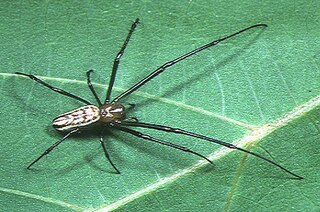
Leucauge subblanda is one of several species of orchard spider found in Russia, China, Korea, Taiwan, and Japan.

Leucauge fastigata, the pear-shaped leucauge, is a species of spiders in the family Tetragnathidae. Its native range extends from India to the Philippines and Sulawesi.
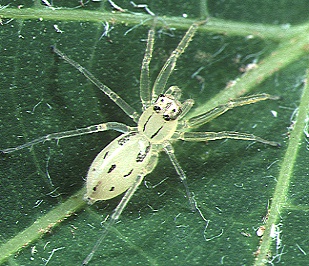
Asemonea tanikawai is a species of jumping spider in the genus Asemonea that is endemic to Japan. It lives in trees in mountain ranges. The spider was first described in 1996 by Hiroyoshi Ikeda. The spider is small, with a carapace [prosoma that between 1.31 and 1.60 mm long and an abdomen is between 1.84 and 2.24 mm long. It is whitish-yellow with a pattern of two brown stripes down the back of the carapace and nine black dots on the back of the abdomen. The male has a distinctive pedipalp with a complex tibial apophysis and a furrow alongside the femoral apophysis, which distinguishes it from the otherwise similar Asemonea maculata and Asemonea pinangensis. The female is also similar, with its copulatory openings hidden in its epigyne. The spider has been found throughout Okinawa and the other Ryukyu Islands.
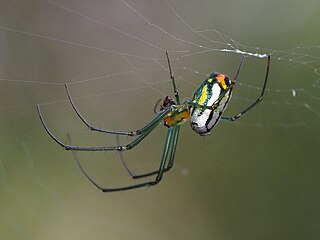
Leucauge argyrobapta, or Mabel's orchard orb weaver, is a species of long-jawed orb weaver in the spider family Tetragnathidae. It is found in Southern part of the USA, Mexico and Brazil, further testing must be done to see if it is found in more of Central and South America.

Leucauge granulata is one of the long-jawed orb weaver spiders. It is found in India, Sri Lanka, China, the Sunda Islands (Indonensia), Australia, and French Polynesia. Leucauge granulata marginata is known to inhabit New Guinea. Leucauge granulata rimitara in French Polynesia.
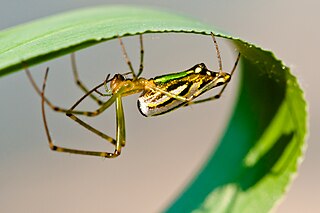
Leucauge decorata, the decorative silver orb spider, is one of the long-jawed orb weaver spiders. A medium to large sized orb weaving spider, with a body length up to 12 mm long (female). Male to 6 mm. This species has a "point" to the end of the abdomen. Found in Africa, India, south east Asia, also to Australia.

Leucauge mariana is a long-jawed orb weaver spider, native to Central America and South America. Its web building and sexual behavior have been studied extensively. Males perform several kinds of courtship behavior to induce females to copulate and to use their sperm.


















